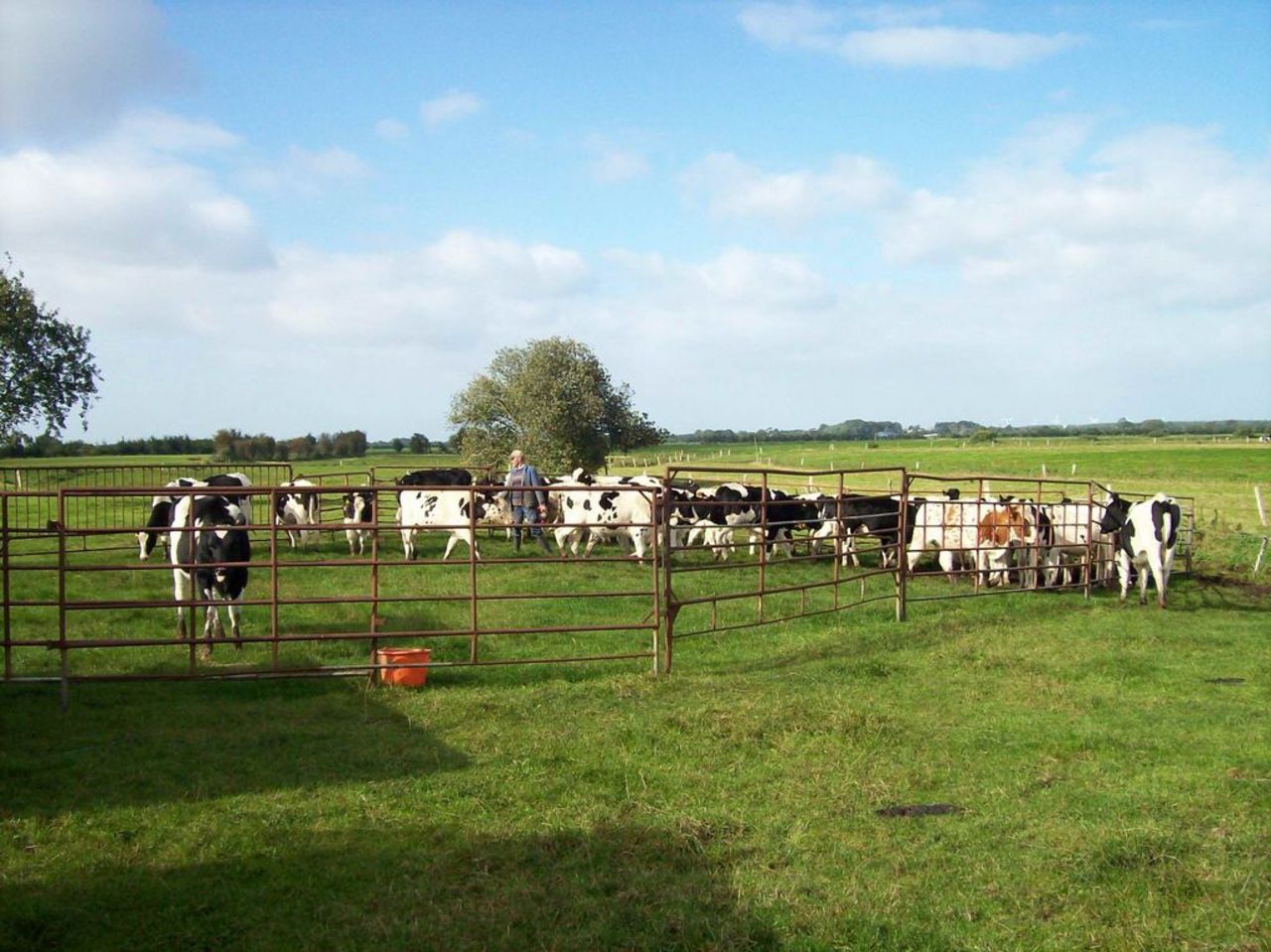Project
Deworming only for individual animals - testing of thresholds in young cattle

Optimization of parasites-control in grazing cattle
Infections with gastrointestinal nematodes (GIN) endanger the grazing of cattle. Until now it was dewormed strategically. This is not sustainable and promotes Anthelmintic Resistance. We tested alternative options.
Involved external Thünen-Partners
-
Freie Universität Berlin
(Berlin, Deutschland)
Background and Objective
Grazing is the best husbandry system for ruminants. But the animals also take in infective stages of gastrointestinal parasites with the fresh forage. Young cattle in their first grazing season are particularly susceptible, because their body's immune response against endoparasites needs ca. 3 – 6 months to build up. The farmer must prevent that parasitic disease occurs, while the animals must get in touch with GIN to stimulate their own defense system. It requires careful planning to coordinate these two objectives.
For environmental reasons, cattle should get anthelmintics sparingly (only treat the right animals and dose accurately) and temporally restrictive (only at the right time). This also helps to delay the spread of resistant worm populations. In the global sheep and goat farming Anthelmintic Resistance grew in recent years already to an existential problem.
The frequent flock treatment should therefore be replaced by alternative control strategies. One approach is the "Targeted Selective Treatment" (TST), which pick out a single animal for deworming. Another alternative is the "Targeted Treatment" (TT). Only if necessary, a treatment of whole flock is performed. An important requirement for the use of TST and TT is the reliable identification of animals in need to treat. It must be found decision criteria and their parameters, which are also sensitive, inexpensive, and easy to use.
The aim of this study was to test decision parameters for the application of TST and TT at first season grazing cattle. These should be both: inexpensive and easy to use and should identify safely animals in need to treat. The primary objective was a reduced use of anthelmintics without losses in productivity of cattle.
Approach
During the grazing seasons in 2010 and 2011, we examined the development of body constitution and the excretion of eggs of GIN in first season grazing cattle at the Federal Research Institute for Organic Agriculture. The 22 and 25 animals belonged to the progeny of the experimental dairy farm. The animals reached an age of about 3 - 6 months at turnout and had no grazing.
2010: Four weeks after grazing together and natural infection two equal experimental groups were formed. The control group was treated with Ivermectin (Ivomec® 0.2 mg / kg sc) three times (in the 8th and 16th week after turnout and at turnin back to stable). The experimental group was not strategically dewormed, but got a targeted individual treatment (TST) with the same medicine. The decision criteria for selective usage of anthelmintics were
- either a combination of a high number of worm eggs in fresh feces (EPG) of ≥ 250 and a low daily weight gain (≤ 250 g / day) since the last sampling day
- or a high EPG (≥ 250) in combination with a declining body condition score (BCS).
The grazing was done separately on a pasture split in the middle. One animal had an area of 0.26 ha available.
2011: Similar to 2010, at the beginning the animals were grazed together and naturally infected. The control group consisted of 7 animals and was treated three weeks after turnout with Moxidectin-Depot (Cydectin 10% LA ® 1.0 mg / kg sc at the back of the ear). The TST group consisted of 9 animals and was treated, if necessary individually with Moxidectin (Cydectin1% ® 0.2 mg / kg sc). The decision criteria for selective treatment were similar to those in the grazing season 2010. In the third experimental group 9 animals were treated according to the approach of targeted treatment (TT). This means that the need of treatment for a single animal (criteria similar to those in the TST group) provokes the treatment of the whole flock and Moxidectin (Cydectin1% ® 0.2 mg / kg sc) was administered.
Due to the additional experimental group the experimental plots, which have been used in 2010, were divided into three equal sections (0.23 ha / animal).
The food supply was equivalent for all groups. The feeding and rotation of pastures remained unchanged in the two years. For stabling in November, the experimental groups were dewormed.
In addition, in both trials more deworming treatments were carried out with Albendazole (2010) or Fenbendazole (2011).
Data and Methods
We evaluated under field conditions whether non-invasive investigation techniques shall be ascertained with parasitic load and what thresholds are appropriate as decision aid for anthelmintic treatment. The investigations were carried out every 14 days over the entire grazing season. The body weight was determined by livestock scales and body condition was recorded as Body Condition Score (BCS) according to Edmonson.
For counting the worm egg output and implementation of Fecal Egg Count Reduction Test to determine the efficacy of anthelmintic drug the modified McMaster method was used with a sensitivity of 33 eggs per gram of fresh feces (EPG).
For the detection of liver fluke eggs, the sedimentation method was used. Fecal cultures were prepared and purified for species differentiation by PCR and Larval Migration Inhibition Assay. For the detection of lung worms the Baermann-Wetzel funnel procedure was used. For the diagnosis of antibodies against liver flukes and lungworms serum was collected and analyzed accordingly. Statistics: R ®; Boot Treat ®, MS Excel ®.
Results
The trial in 2010 showed that one animal of the TST - group crossed the threshold and was treated once. All animals remained clinically normal. The body weight gain was not significantly different between the groups (multivariate analysis, p> 0.05). The average daily weight gain during the grazing season amounted to 0.854 kg for the control group and 0.800 kg for the TST group.
In the grazing season 2011 Ivermectin was changed to Moxidectin and Fenbendazole to possibly circumvent resistant fractions of the worm population. Again one animal of the TST group met the criteria and got dewormed with Fenbendazole once. The entire TT group received treatment with Moxidectin at mid-July and in early September a second treatment with Fenbendazole. The control group was provided at turnout with a subcutaneous depot of Moxidectin and then again treated in early August with Moxidectin. Thereafter, these young cattle were still treated in early September and early October with Fenbendazole to keep the EPG close to zero. All animals remained clinically healthy. The body weight gain was not significantly different between the groups (multivariate analysis, both p> 0.05). The average daily weight gain during the grazing season amounted to 1.009 kg for the control group, 0.991 kg for the TST group and 0.894 kg for the TT group. As indication for the contamination of pastures, the mean egg excretion can be pulled over the entire grazing period. The mean EPG was 6.6 EPG in the control group, 84.2 EPG in the TST-group and 63.5 EPG in the TT-group.
In the two seasons body condition expressed in BCS values was assessed related to body weights with R² of 0.68 and 0.54, respectively.
Since in both years group membership had no significant influence on the weight gain of the animals, the underlying thresholds have been successfully evaluated.
The enormous decrease in use of pharmaceuticals compared with the control group was evident in the TST-group (Macrocyclic Lactones: ca. 95%) and in the TT-group (about 80%). In this study there were no significant performance degradation found. In another study, however, this was the case (Hoglund, J., Dahlstrom, F., Sollenberg, S., Hessle, A. (2013) Weight gain-based targeted selective treatments (TST) of gastrointestinal nematodes in first-season grazing cattle. Vet. Parasitol. 196, 358-365). The thresholds used in our study should therefore be tested in larger herds and over several years.
With the new deworming strategies the larval stocking could eventually increase on the pasture. Therefore farmers should implement additional pasture management measures, such as pasture rest, mowing or rotation cycles.
The species identification revealed that in most samples Ostertagia ostertagi and Cooperia oncophora were present. The studies with the Fecal Egg Count Reduction Test and the Larval Migration Inhibition Assay have detected a suspect of reduced efficacy of Ivermectin and Moxidectin. The used benzimidazoles (Albendazole and Fenbendazole) showed no evidence for the presence of resistance.
In both years no stages of fluke or lung worms were found in feces. In 2010, however, some young animals had serological lungworm findings, indicating an infection.
In smaller flocks with trusting animals a targeted individual treatment (TST) can be done without problems. While for large herds with high stocking density the targeted treatment of the entire herd (TT) would be preferable. Both methods showed a large potential for reducing the amount of anthelmintics. In addition, suitable pasture management measures (such as pasture rest, mowing, rotation cycles) should be implemented.
Links and Downloads
- Dissertation von Jana Fahrenkrog (pdf)
Involved external Thünen-Partners
-
Freie Universität Berlin
(Berlin, Deutschland)
Duration
1.2010 - 12.2012
More Information
Project status:
finished
Publications
- 0
Koopmann R, Kühne S (2017) Entwurmungsmittel im Dung - ein Risiko für Nicht-Ziel-Organismen. Tierärztl Umsch 72(10):392-395
- 1
Koopmann R, Kühne S (2017) Tierarzneimittel (Antiparasitika) im Kuhfladen - Ein Risiko für Nicht-Ziel-Organismen (Literaturübersicht). Landbauforsch Appl Agric Forestry Res 67(2):70-92, DOI:10.3220/LBF1501500814000
- 2
Fahrenkrog J (2013) Optimierung der Parasitenbekämpfung bei Weidehaltung von Rindern. 137 p, Berlin, Freie Univ, Diss, 2013
- 3
Fahrenkrog J, Koopmann R, Samson-Himmelstjerna G von, Demeler J (2011) Targeted Selective Treatment (TST) bei Rindern zur Reduzierung der Resistenzbildung bei Endoparasiten. Landbauforsch SH 346:71-76

![[Translate to English:] [Translate to English:]](/media/_processed_/8/e/csm_Bildschirmfoto_2021-03-03_bearb_fc48ac88bf.jpeg)
![[Translate to English:] [Translate to English:]](/media/_processed_/8/e/csm_Bildschirmfoto_2021-03-03_bearb_ba3ec0e9d7.jpeg)

![[Translate to English:] Logo des Bundesministerium für Ernährung und Landwirtschaft](/media/allgemein/logos/BMEL_Logo.svg)